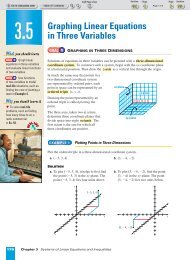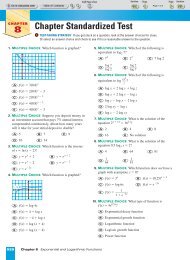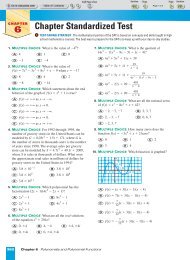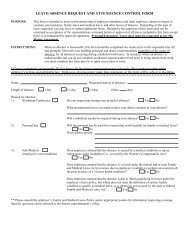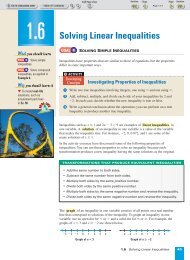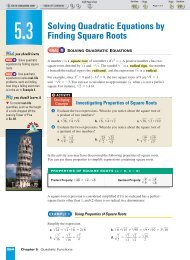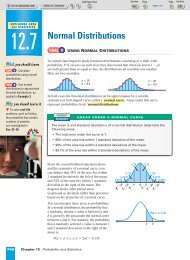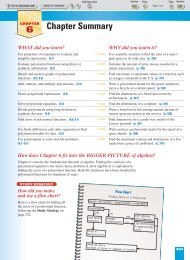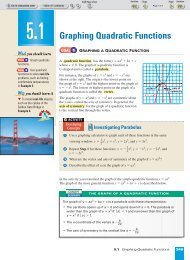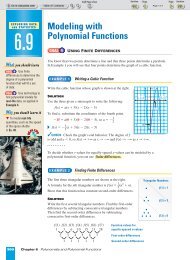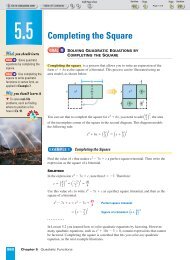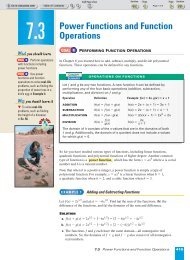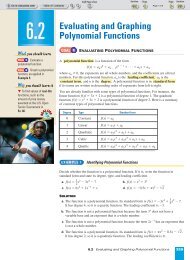Inverse Functions - Beau Chene High School Home Page
Inverse Functions - Beau Chene High School Home Page
Inverse Functions - Beau Chene High School Home Page
You also want an ePaper? Increase the reach of your titles
YUMPU automatically turns print PDFs into web optimized ePapers that Google loves.
STUDENT HELP<br />
HOMEWORK HELP<br />
Visit our Web site<br />
www.mcdougallittell.com<br />
for help with problem<br />
solving in Ex. 62.<br />
INTERNET<br />
Test<br />
Preparation<br />
59. BOWLING In bowling a handicap is a change in score to adjust for<br />
differences in players’ abilities. You belong to a bowling league in which each<br />
bowler’s handicap h is determined by his or her average a using this formula:<br />
h = 0.9(200 º a)<br />
(If the bowler’s average is over 200, the handicap is 0.) Find the inverse of the<br />
function. Then find your average if your handicap is 27.<br />
60. GAMES You and a friend are playing a number-guessing game. You ask<br />
your friend to think of a positive number, square the number, multiply the result<br />
by 2, and then add 3. If your friend’s final answer is 53, what was the original<br />
number chosen? Use an inverse function in your solution.<br />
61. FISH The weight w (in kilograms) of a hake, a<br />
type of fish, is related to its length l (in centimeters)<br />
by this function:<br />
w = (9.37 ª 10 º6 )l 3<br />
Find the inverse of the function. Then determine<br />
the approximate length of a hake that weighs<br />
0.679 kilogram. Source: Fishbyte<br />
62. SHELVES The weight w (in pounds) that can be supported by a shelf made<br />
from half-inch Douglas fir plywood can be modeled by<br />
3<br />
w = 82 .9<br />
d<br />
where d is the distance (in inches) between the supports for the shelf. Find the<br />
inverse of the function. Then find the distance between the supports of a shelf<br />
that can hold a set of encyclopedias weighing 66 pounds.<br />
QUANTITATIVE COMPARISON In Exercises 63 and 64, choose the statement<br />
that is true about the given quantities.<br />
¡ A The quantity in column A is greater.<br />
¡ B The quantity in column B is greater.<br />
Hake<br />
¡ C The two quantities are equal.<br />
¡ D The relationship cannot be determined from the given information.<br />
63.<br />
64.<br />
Column A<br />
Column B<br />
ƒ º1 (3) where ƒ(x) = 6x + 1 ƒ º1 (º4) where ƒ(x) = º2x + 9<br />
ƒ º1 (2) where ƒ(x) = º5x 3 ƒ º1 (0) where ƒ(x) = x 3 + 14<br />
★ Challenge<br />
EXTRA CHALLENGE<br />
www.mcdougallittell.com<br />
INVERSE FUNCTIONS Complete Exercises 65–68 to explore functions that are<br />
their own inverses.<br />
65. VISUAL THINKING The functions ƒ(x) = x and g(x) = ºx are their own<br />
inverses. Graph each function and explain why this is true.<br />
66. Graph other linear functions that are their own inverses.<br />
67. Write equations of the lines you graphed in Exercise 66.<br />
68. Use your equations from Exercise 67 to find a general formula for a family of<br />
linear equations that are their own inverses.<br />
428 Chapter 7 Powers, Roots, and Radicals



